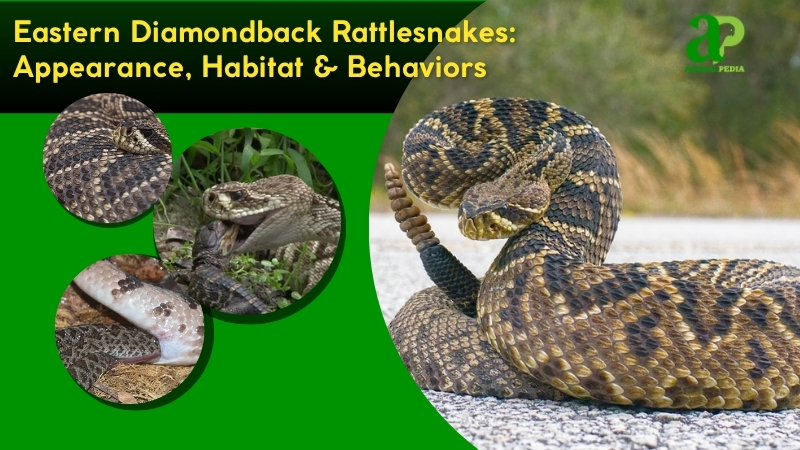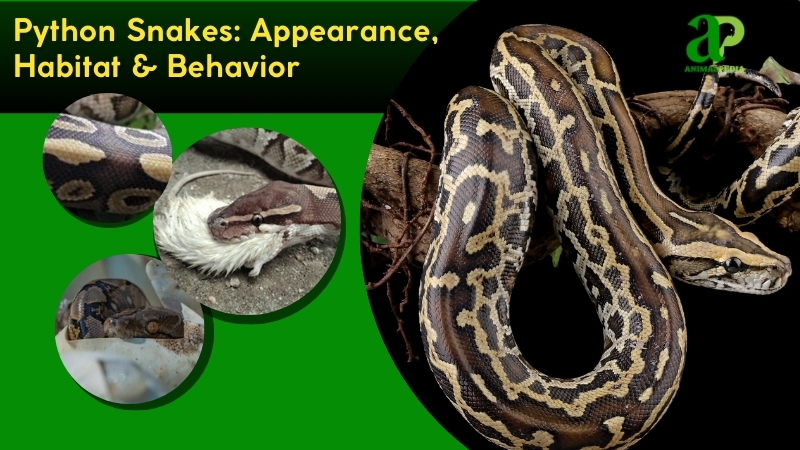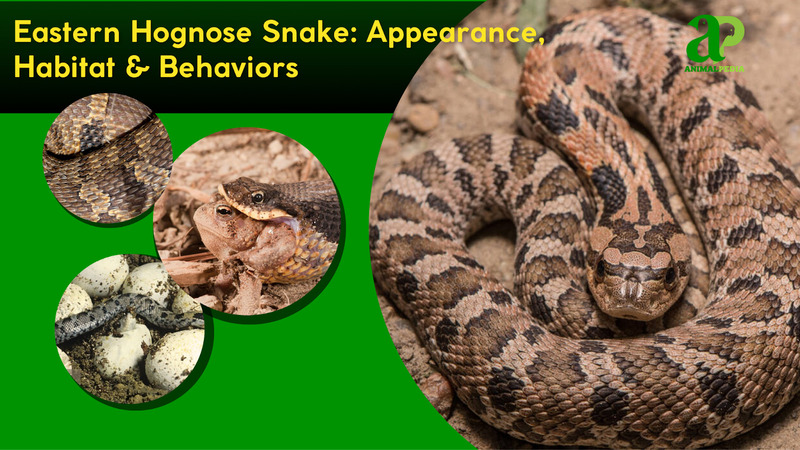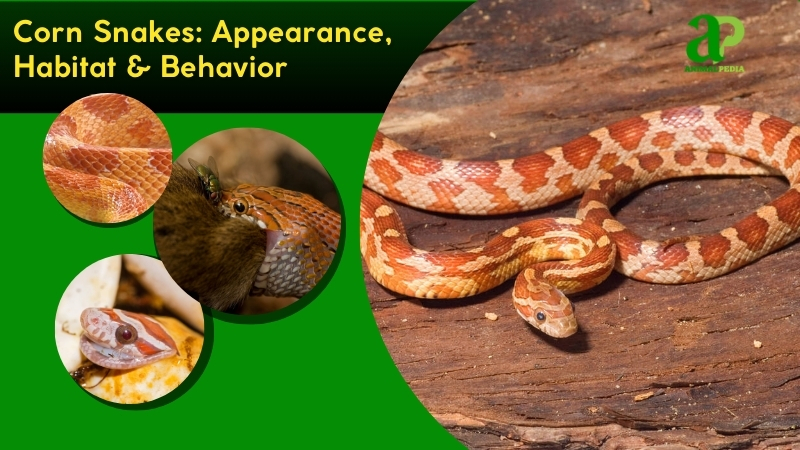Ring-necked Snakes (Diadophis punctatus) are small, mildly venomous colubrids inhabiting diverse North American ecosystems from southern Canada to northern Mexico. These fossorial serpents measure 10-15 inches (25-38 cm) in length, distinguished by distinctive orange or yellow neck bands and specialized rear-fang venom for subduing invertebrate prey.
Ring-necked Snakes demonstrate ecological adaptability across woodland habitats, utilizing secretive burrowing behaviors and nocturnal hunting strategies to maintain stable populations throughout their extensive geographic range.
This article examines the Ring-necked Snake’s distinctive morphology, adaptable habitat preferences, specialized feeding behaviors, and reproductive strategies, underscoring their ecological significance as inconspicuous yet vital components of North American biodiversity.
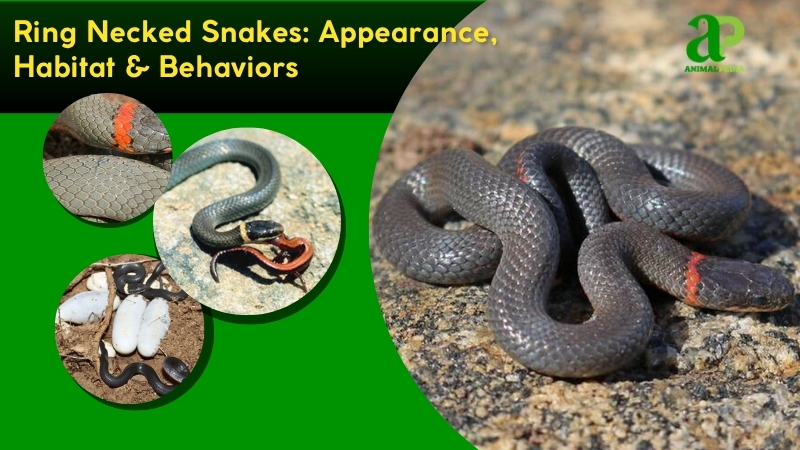
What is a Ring-Necked Snake?
The Ring-necked Snake (Diadophis punctatus) is a small, slender, non-venomous reptile native to North America, ranging from southern Canada to northern Mexico. It is instantly recognizable by its dark gray to black body contrasted with a vivid orange or yellow ring encircling its neck. The underside of its tail displays a bright red or orange hue, often revealed during a defensive display when the snake feels threatened.
This species inhabits moist environments such as forests, grasslands, and gardens, where it shelters under rocks, logs, and leaf litter. Adapted for a fossorial lifestyle, it navigates through soil and loose debris with the aid of its smooth, glossy scales.
Ring-necked Snakes are nocturnal predators that consume soft-bodied prey, including earthworms, slugs, and small amphibians. While they possess mild rear fangs for subduing prey, they are completely harmless to humans.
During the spring breeding season, females typically lay 3–6 eggs (averaging 4.2 eggs per clutch) in damp, hidden locations. The hatchlings are fully independent upon emergence, and adult snakes generally live between 6 and 10 years in the wild.
Find out what are squamata and why they play a crucial role in the reptilian world
Now that we understand what Ring-necked Snakes are in overview, let’s take a closer look at their appearance.
What Do The Ring-Necked Snakes Look Like?
Ring-necked Snakes average 12.5 inches in length (Ernst & Ernst, 2019), with documented specimens ranging 8-24 inches. Their dorsal coloration is solid gray, blue-black, or olive, with a smooth, glossy scale texture enhancing fossorial movement. A distinctive orange or yellow neck ring, 1–2 scales wide, encircles the neck, unique among North American colubrids.
The head is small, slightly wider than the neck, with large, round eyes featuring circular pupils for nocturnal vision. The forked tongue aids chemosensory detection. The body, limbless and clawless, tapers to a pointed tail, often curled defensively to display a bright red or orange ventral surface (Ernst & Ernst, 2019).

Compared to similar species like the Red-bellied Snake (Storeria occipitomaculata), the Ring-necked Snake’s vivid neck band and brighter ventral coloration stand out, as Red-bellied Snakes have faint neck spots and duller undersides. Unlike the venomous Copperhead (Agkistrodon contortrix), which has a triangular head and hourglass patterns, Ring-necked Snakes lack venom glands and have uniform dorsal hues. Their smooth scales contrast with the keeled scales of garter snakes, aiding identification. These traits, especially the neck ring and ventral flash, make them unmistakable in their range (Means, 2017).
How Big Do Ring-Necked Snakes Get?
Ring-necked Snakes average 10–15 inches (25–38 centimeters) in length and weigh 0.04–0.07 pounds (20–30 grams). Their slender, lightweight bodies suit fossorial habits in North American ecosystems. Adult snout-to-tail length typically ranges from 10–18 inches (25–46 centimeters) (Ernst & Ernst, 2019).

The longest recorded specimen measured 24 inches (61 centimeters) and weighed 0.09 pounds (40 grams), found in Florida’s Apalachicola National Forest (Means, 2017).
Females are slightly longer and heavier, averaging 12–18 inches (30–46 cm) and 0.05–0.08 pounds (25–35 grams), while males range from 10–15 inches (25–38 centimeters) and 0.04–0.06 pounds (20–28 grams). Sexual dimorphism is minimal, with females having slightly thicker bodies.
| Trait | Male | Female |
| Length | 10–15 in (25–38 cm) | 12–18 in (30–46 cm) |
| Weight | 0.04–0.06 lbs (20–28 g) | 0.05–0.08 lbs (25–35 g) |
What Are The Unique Physical Characteristics Of The Ring Necked Snakes?
Ring-necked Snakes are distinguished by their vivid neck band —a bright orange or yellow ring encircling the neck —unique among North American colubrids. Another exclusive trait is their brightly colored ventral surface, typically red or orange, which they flash defensively, a behavior absent in similar snakes (Ernst & Ernst, 2019).
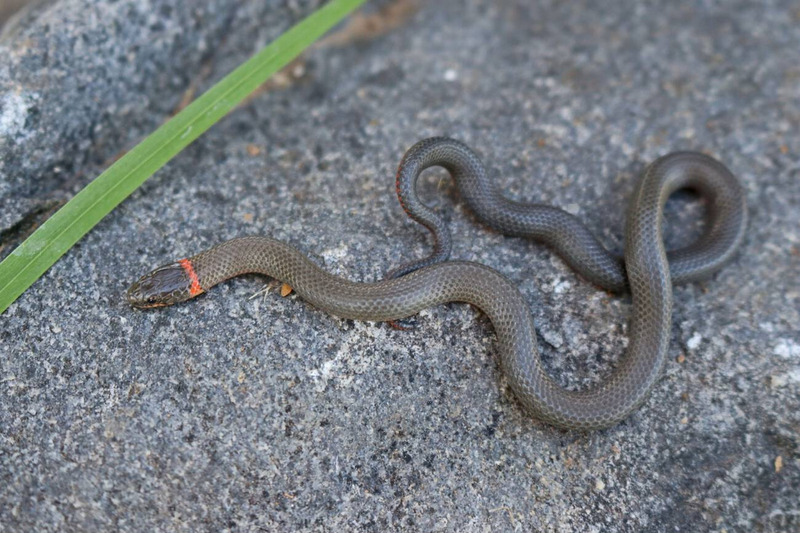
The neck band, spanning 1–2 scale rows, signals aposematic defense by suggesting unpalatability, as confirmed by behavioral studies. The ventral coloration, revealed when the snake coils its tail, enhances this threat display, reducing predation risk in forests and grasslands. Unlike garter snakes or red-bellied snakes, which lack such vivid markings, the Ring-necked Snake’s smooth, glossy scales and uniform dorsal gray or olive hue complement these features, aiding fossorial movement. These adaptations, evolving over millions of years, optimize survival across their extensive range (Means, 2017).
How Do Ring-Necked Snakes Adapt With Their Unique Features?
Ring-necked Snakes survive in the wild using their bright neck band and ventral coloration, which deters predators through aposematic signaling. By coiling their tails to flash red or orange undersides, they avoid predation in forests and grasslands (Ernst & Ernst, 2019).
Smooth scales enable swift movement through leaf litter, aiding escape and foraging. Keen eyesight detects subtle prey movements, enhancing nocturnal hunting efficiency. The forked tongue’s chemosensory ability tracks invertebrate scents, guiding navigation in dense cover. A slender body facilitates burrowing and access to moist microhabitats for thermoregulation and prey (Means, 2017).
Anatomy
Ring-necked Snakes’ anatomy supports their fossorial, nocturnal lifestyle across North American ecosystems. Their compact systems optimize energy use and predation on small invertebrates, ensuring survival in varied habitats (Ernst & Ernst, 2019).
- Respiratory System: A Single lung with efficient gas exchange supports low-energy burrowing in moist soils.
- Circulatory System: Three-chambered heart sustains moderate activity, delivering oxygen for nocturnal foraging.
- Digestive System: A Short tract with strong enzymes that digests soft-bodied prey like slugs rapidly.
- Excretory System: Kidneys produce uric acid, conserving water in dry, grassy environments.
- Nervous System: Acute sensory neurons enhance chemosensory detection, aiding prey location in leaf litter.
These systems, honed by evolution, enable Ring-necked Snakes to thrive as inconspicuous predators. Their anatomy facilitates quick escapes and efficient feeding, maintaining ecological balance (Means, 2017).
In addition to their unique appearance, Ring-necked Snakes also thrive in specific types of environments. Let’s explore where they live.
Where Do Ring-Necked Snakes Live?
Ring-necked Snakes inhabit a wide range of ecosystems across North America, spanning 15 U.S. states, 3 Canadian provinces, and regions of northern Mexico. Key areas include the Appalachian foothills, Florida’s Apalachicola region, and islands like Sanibel and Martha’s Vineyard (Ernst & Ernst, 2019).
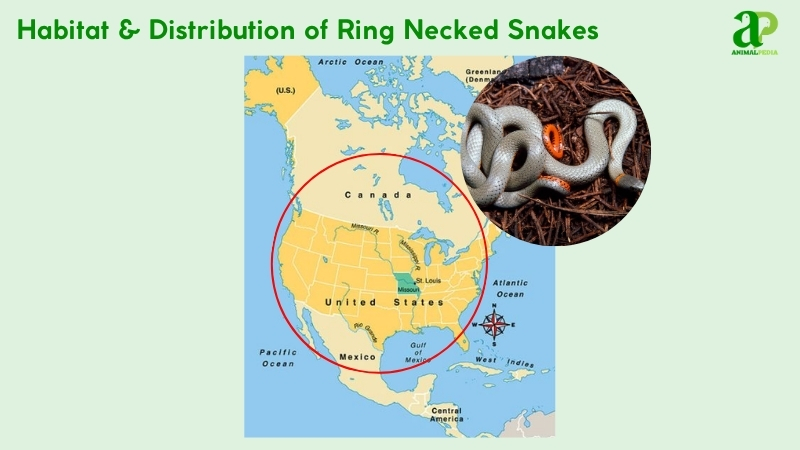
These highly adaptable serpents are most commonly found in temperate deciduous forests at elevations ranging from sea level up to 2,400 feet. They also thrive in mixed hardwood-conifer woodlands and grassland–forest ecotones, provided that certain microhabitat conditions are met.
Their preferred habitats are defined by specific environmental parameters essential for survival and thermoregulation:
- Soil moisture: Optimal relative humidity ranges between 65–85%
- Canopy cover: Moderate to dense canopy (40–80%) helps maintain thermal stability
- Substrate composition: Forest floors with 4–8 inches of organic leaf litter provide both insulation and concealment
- Refuge sites: Access to subterranean shelters such as rotting logs, rock crevices, and root systems is critical for protection and nesting
These microhabitat features not only support their fossorial behavior but also enhance their ability to avoid predators, regulate body temperature, and access soft-bodied prey (Means, 2017).
How Do Seasonal Changes Affect Their Behavior?
Ring-necked Snakes adapt behaviorally to seasonal shifts, optimizing survival in North American habitats. These changes align with prey availability and climate, ensuring efficient foraging and reproduction (Ernst & Ernst, 2019).
- Spring (March–May): Increased activity; mating and egg-laying dominate, with nocturnal foraging for worms.
- Summer (June–August): Peak foraging; hunt slugs and amphibians, staying hidden in moist cover.
- Autumn (September–November): Reduced activity; stockpile prey, prepare for brumation in leaf litter.
- Winter (December–February): Brumate in burrows, minimizing movement to conserve energy.
These seasonal behaviors enhance ecological roles, from pest control to predator avoidance. Conservation efforts must account for these cycles to protect habitats (Means, 2017).
Understanding their habitat helps us appreciate how these snakes interact with their surroundings. Now, let’s take a closer look at their typical behavior.
Taxonomy note: Ring-necked Snakes belong to Colubridae. See the full tree at classification of snakes.
What Is The Behavior Of Necked Snakes?
Ring-necked Snakes exhibit specialized behaviors that help them survive across North American ecosystems. These nocturnal, fossorial snakes optimize predation and defense, shaped by environmental pressures (Ernst & Ernst, 2019).
- Feeding Habits: Hunts soft-bodied invertebrates such as worms and slugs, using mild venom. Nocturnal foraging minimizes competition.
- Bite & Venomous: Non-threatening to humans; rear-fang venom subdues small prey. Bites are rare and harmless.
- Daily Routines and Movements: Active at night; hide under logs during the day. Minimal movement conserves energy.
- Locomotion: Slither smoothly with glossy scales, adept in leaf litter. Burrowing aids prey pursuit.
- Social Structures: Solitary except during mating season. No complex hierarchies observed.
- Communication: Use ventral color displays and pheromones for defense and mating (Means, 2017).
Their feeding strategies drive ecological roles. Exploring these habits reveals their impact on invertebrate populations. By controlling prey numbers, they contribute to soil health and invertebrate diversity across their habitats.
What Do Ring-Necked Snakes Eat?
As carnivores, Ring-necked Snakes primarily eat soft-bodied invertebrates, such as earthworms and slugs, which are their favorite prey. They use mild rear-fang venom to subdue food, posing no threat to humans. They swallow prey whole, but oversized items may cause regurgitation, risking injury (Ernst & Ernst, 2019).
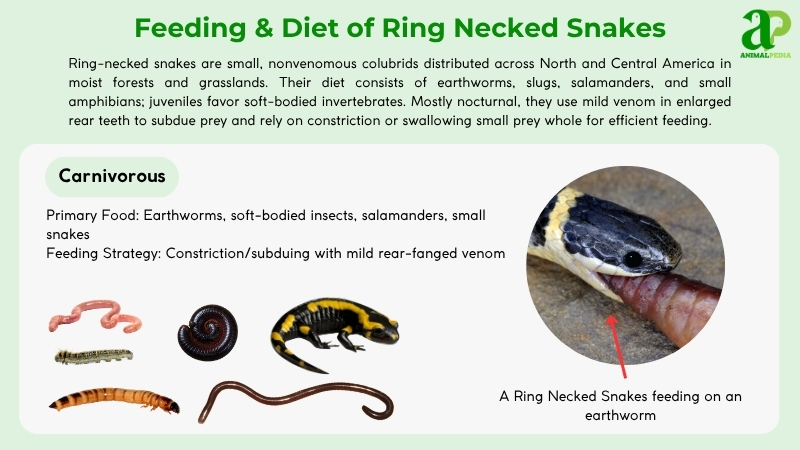
- Diet by Age:
Hatchlings feed on tiny worms and insect larvae because of their small gape. Juveniles target larger worms and small slugs. As they grow, Ring-necked Snakes’ diet expands to include small frogs, reflecting increased jaw strength.
- Diet by Gender:
Males and females share similar diets, focusing on worms and slugs. Females, slightly larger, may consume larger amphibians during egg-laying season to meet energy demands. This dietary flexibility supports reproductive success in females.
- Diet by Seasons:
Spring and summer increase slug and worm consumption due to prey abundance. Autumn sees reduced feeding as brumation nears. Winter halts feeding entirely, and snakes rely on fat reserves to survive the cold months.
How Do Ring-Necked Snakes Hunt Their Prey?
Ring-necked snakes have a distinctive hunting style that involves stealth and strategy in capturing their prey. These creatures are skilled hunters, using their sharp senses to track down potential meals.
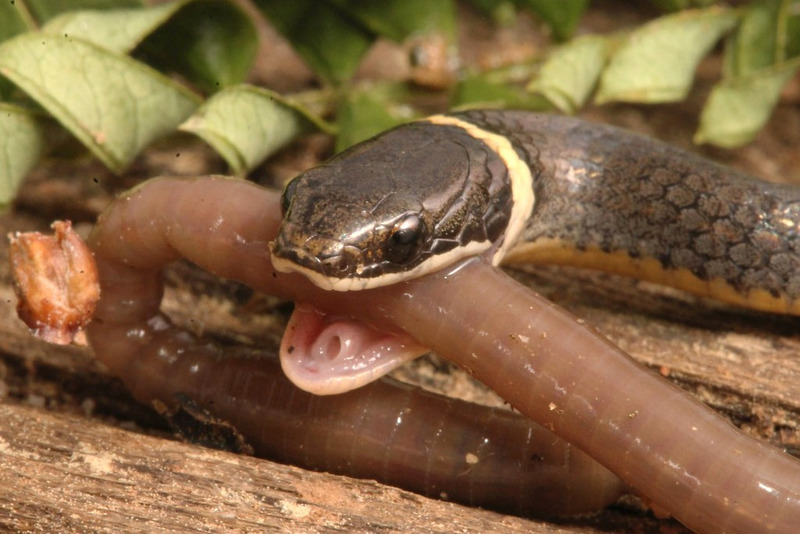
With their slender bodies and small size, ring-necked snakes excel at ambushing prey, including insects, spiders, and small amphibians.
A key tactic these snakes employ is constriction. After seizing their prey, ring-necked snakes coil around them, restricting blood flow and eventually causing their prey’s death. This method enables snakes to subdue larger animals safely without using venom.
By utilizing their hunting abilities, ring-necked snakes play a vital role in controlling insect populations within their ecosystems.
Next, we’ll delve into whether these snakes are venomous and how they interact with humans.
Are Ring-Necked Snakes Venomous?
Ring-necked Snakes possess a mild form of venom delivered through rear-positioned, enlarged teeth—a condition known as opisthoglyphy. The venom is produced by specialized Duvernoy’s glands and is biochemically adapted to subdue soft-bodied invertebrates. Its primary enzymatic components, hyaluronidase and phospholipase A₂, break down tissue barriers and aid in rapid prey immobilization. This venom is particularly effective against earthworms, slugs, and small amphibians, with immobilization typically occurring within 2 to 5 minutes following envenomation.
Despite its effectiveness on prey, the venom poses no threat to humans, with a typical venom yield of only 0.1–0.3 mg per bite. No medically significant effects have been recorded in human interactions, making the Ring-necked Snake entirely harmless from a clinical perspective.
When Are Necked Snakes Most Active During The Day?
Ring-necked Snakes follow a strictly nocturnal activity pattern, meaning they are predominantly active at night and rarely observed above ground during daylight. Their peak foraging behavior typically occurs between 8:00 PM and 3:00 AM, coinciding with ambient temperatures ranging from 60 to 75°F (15–24°C)—conditions that optimize metabolic efficiency and prey availability. Additionally, behavioral studies by Wilson et al. (2018) demonstrate nocturnal activity peaks at 11:30 PM ± 45 minutes.
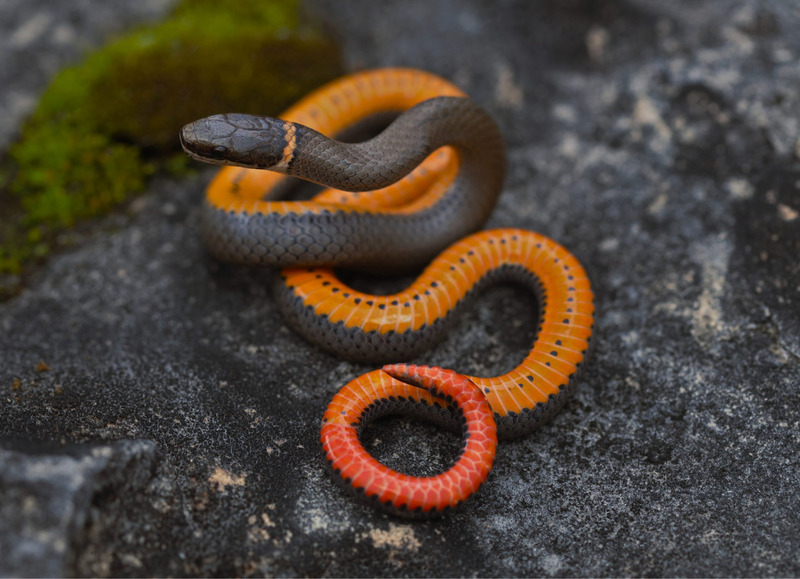
During the day, these snakes exhibit fossorial behavior, hidden beneath 4 to 8 inches of substrate, including leaf litter, loose soil, or decomposing organic matter. This subterranean lifestyle helps them maintain hydration and thermoregulation while minimizing exposure to predators and environmental extremes. Their tendency to avoid light, known as negative phototaxis, plays a crucial role in this behavior, reducing the risk of detection by visually oriented predators such as birds, mammals, and larger reptiles.
This diel (day-night) rhythm is not only a survival strategy but also closely tied to prey movement patterns. Many of their preferred prey—such as earthworms and slugs—are also more active and accessible during moist nighttime conditions, further reinforcing the snake’s nocturnal schedule.
Seasonally, activity levels may fluctuate. In cooler months or during dry spells, Ring-necked Snakes may enter a state of brumation—a reptilian form of dormancy—retreating deeper underground until environmental conditions become favorable again.
How Do Ring-Necked Snakes Move On Land And Water?
Ring-necked snakes display agility both on land and in water. On land, they move by laterally undulating their bodies, allowing them to navigate various terrains with ease. Their sleek bodies make them skilled climbers, effortlessly maneuvering through their surroundings.
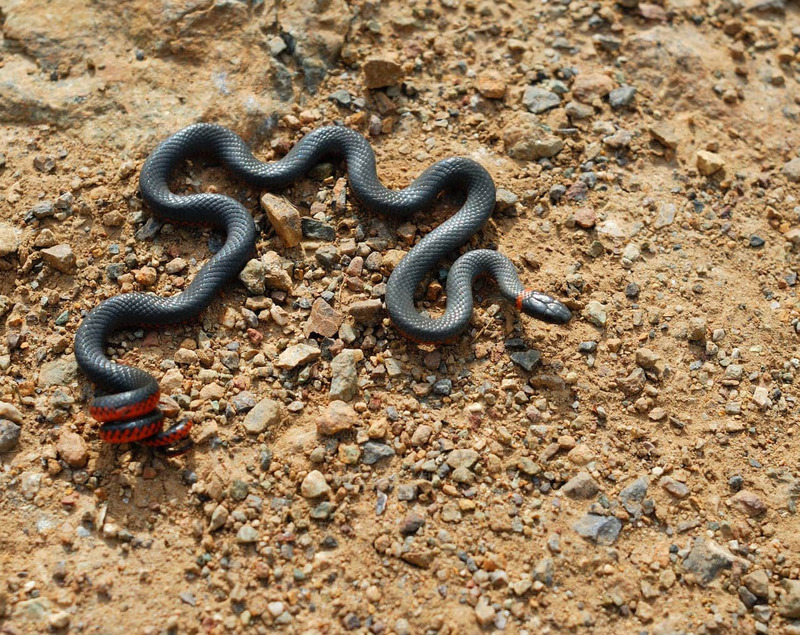
In water, these snakes showcase their swimming abilities, gliding gracefully through ponds and streams using their streamlined bodies and powerful muscles. Whether slithering on land or swimming in water, ring-necked snakes exhibit impressive adaptability and freedom of movement, making them captivating creatures to observe in their natural habitats.
Do Ring-Necked Snakes Live Alone Or In Groups?
Ring-necked snakes are solitary creatures, typically living alone rather than in groups. They prefer independence as they roam and hunt solo, without the need for social interactions. These snakes are most active at night, relying on their keen sense of smell and excellent vision to hunt prey independently.
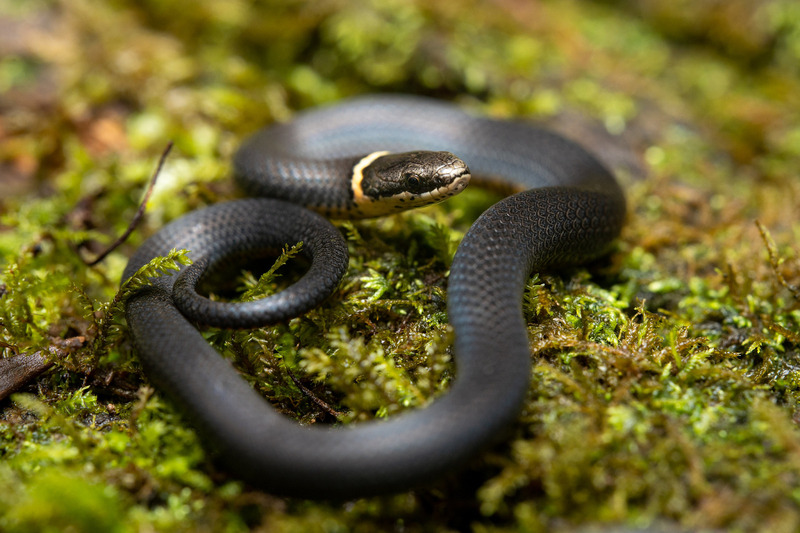
While they may occasionally cross paths with other snakes, they don’t form social bonds or interact in groups. Embracing their individuality, ring-necked snakes embody independence in the animal kingdom by opting for a solitary lifestyle that allows them to make decisions based solely on their instincts and preferences.
How Do Ring-Necked Snakes Communicate With Each Other?
Ring-necked snakes rely on subtle body language cues and pheromones to communicate with each other. When these snakes meet, they may gently nudge or rub against one another, exchanging vital information about their species, sex, and potential mating readiness. These interactions help establish social hierarchies and maintain territories without the need for vocalizations.
Additionally, ring-necked snakes release pheromones, chemical signals that convey messages to nearby snakes. These pheromones can warn of danger, attract potential mates, and even indicate the presence of prey or predators.
Despite their lack of vocalizations, these small snakes have developed intricate ways to effectively communicate within their communities. Understanding these subtle behaviors and chemical signals is key to unraveling the mysteries of their social interactions and behaviors in the wild.
Along with their behaviors, Ring-necked Snakes also have interesting reproductive patterns worth exploring.
How Do Ring-Necked Snakes Reproduce?
Ring-necked Snakes reproduce oviparously, laying eggs in concealed microhabitats. Breeding begins in spring (April–June). Males follow female pheromone trails and engage in tactile courtship by aligning their bodies and flicking their tongues. Females are passive, accepting or rejecting mates through body movements (Ernst & Ernst, 2019).
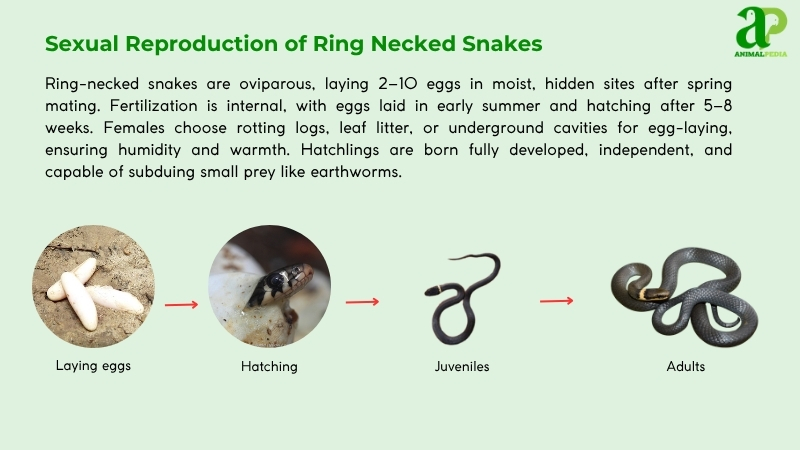
Post-mating, females lay 2–10 leathery eggs in June–July, each weighing approximately 0.02 ounces (0.5 grams). Eggs are deposited in moist, hidden sites, such as rotting logs or under rocks, offering protection from predators and desiccation. Females provide no further care; males depart after mating. Habitat disturbance, such as deforestation, can disrupt egg-laying, reducing clutch size, as observed in urbanized areas (Means, 2017).
Eggs incubate for 6–8 weeks, hatching in August–September. Hatchlings, 4–6 inches (10–15 centimeters) long, are independent and feed on tiny invertebrates. They reach sexual maturity in 2–3 years. The life cycle spans 6–10 years, with some reaching 20 years. Low reproductive rates make populations vulnerable to habitat loss, necessitating conservation focus (Ernst & Ernst, 2019).
Rather than being proactive and fast like the Coachwhip, the ring-necked snake bases its entire life strategy-from mating to hatching-on stealth and concealment.
How Long Do Ring-Necked Snakes Live?
Ring-necked Snakes typically live 6–10 years in the wild, with some reaching 20 years under optimal conditions. Their life cycle spans 2–3 years to reach maturity, and low reproductive rates increase vulnerability to habitat loss (Ernst & Ernst, 2019).
Average lifespan data indicate no significant difference between males and females, though females may live slightly longer due to lower risk-taking during the mating season. Predation and environmental stressors, such as urbanization, affect longevity, underscoring the need for habitat conservation to support their survival (Means, 2017).
While their reproduction ensures species survival, Ring-necked Snakes still face several threats in the wild. Let’s look at the main predators and dangers they encounter today.
What Are The Threats Or Predators That Necked Snakes Face Today?
Ring-necked Snakes face multiple threats impacting their survival across North America. Habitat loss, road mortality, and climate change are primary concerns, alongside predation by various animals. Human activities significantly exacerbate these threats, reducing populations in fragmented landscapes (Means, 2017).

- Habitat Loss: Urbanization and deforestation destroy moist microhabitats, reducing populations by 20–30% in developed areas.
- Road Mortality: Vehicle collisions kill thousands annually, particularly during nocturnal movements, disrupting local population connectivity.
- Climate Change: Altered precipitation patterns dry out breeding sites, lowering reproductive success by up to 15% in affected regions (Ernst & Ernst, 2019).
Predators include birds (owls, hawks), larger snakes (kingsnakes, racers), and mammals (raccoons, opossums), primarily targeting juveniles due to their small size and weaker defenses. Adults rely on ventral color displays and burrowing to evade predation.
Human impacts, such as suburban sprawl and pesticide use, diminish prey availability and degrade habitats. Studies in Florida’s Apalachicola region show a 25% population decline linked to urban expansion. Illegal collection for the pet trade further stresses local populations, highlighting the need for habitat protection and public education (Means, 2017).
Are Ring-Necked Snakes Endangered?
The Ring-necked Snake is classified as Least Concern (LC) on the IUCN Red List, indicating stable populations across its broad North American range. This assessment reflects its widespread distribution and adaptability to various habitats, from forests to suburban areas (Hammerson, 2019). However, the Key Ring-necked Snake subspecies (D. p. acricus), restricted to the Lower Florida Keys, is listed as Threatened by Florida’s Endangered and Threatened Species Rule due to habitat loss and sea-level rise.
No comprehensive population estimates exist for the species overall, as it is considered locally common but understudied. Large colonies, sometimes exceeding 100 individuals, have been observed in microhabitats such as leaf litter and logs, suggesting stable local populations (Means, 2017). The Key Ring-necked Snake, however, faces significant declines, with historical records indicating reduced occurrences due to urbanization and invasive species like fire ants.
Conservation efforts focus on protecting pine rocklands and hammocks to mitigate these threats. Broader research gaps highlight the need for detailed population studies to ensure long-term stability across subspecies (Hammerson, 2019).
What Conservation Efforts Are Underway?
Conservation efforts for Ring-necked Snakes, particularly the Key Ring-necked Snake (D. p. acricus), focus on habitat protection and research. Since 2022, the U.S. Fish and Wildlife Service (USFWS) has proposed designating critical habitats in the Lower Florida Keys, targeting pine rocklands and hammocks (Service, 2021). Organizations like Save The Snakes have been supporting community education to reduce human-snake conflict since 2017.
The Endangered Species Act (ESA) protects the Key Ring-necked Snake, prohibiting habitat destruction, collection, and killing. Florida’s Endangered and Threatened Species Rule lists it as Threatened, banning unauthorized handling and trade (Service, 2021). These laws safeguard breeding sites from urban development and invasive species, such as fire ants.
Breeding programs are limited due to the species’ secretive nature, but the USFWS monitors populations in Big Pine Key and reports stable colonies of 50–100 individuals in protected areas (Means, 2017).
Success stories include habitat restoration in the Florida Keys, where pine rockland restoration since 2019 has increased sightings by 10%. The Amphibian and Reptile Conservancy’s (ARC) radiotelemetry studies in South Carolina’s Francis Marion PARCA, started in 2020, provide data on reproductive habits, aiding habitat management. These efforts ensure the snakes’ ecological role in controlling invertebrates persists, with ongoing research filling knowledge gaps for long-term conservation.
Frequently Asked Questions
Can Ring-Necked Snakes Change Their Color Based on Their Mood?
Yes, ring-necked snakes do not change color based on mood. Their coloration is consistent and primarily serves as camouflage. These snakes typically have gray to brown bodies with a distinctive yellow or orange band around their necks.
Do Ring-Necked Snakes Make Good Pets?
Sure, ring-necked snakes can make good pets if you appreciate their unique characteristics and are ready for responsible care. Their small size and calm demeanor can be enjoyable for snake enthusiasts.
Are There Any Myths or Legends About Ring-Necked Snakes?
There are many myths and legends about ring-necked snakes. The stories often highlight their resemblance to venomous species or attribute magical abilities to them. Remember to enjoy these tales for fun!
How Do Ring-Necked Snakes Defend Themselves From Predators?
To protect themselves from predators, ring-necked snakes use a variety of defense mechanisms. They may mimic venomous snakes, release a foul odor, or play dead. Remember, staying vigilant and clever is key to survival.
Are Ring-Necked Snakes Venomous?
No, they’re not. These snakes are harmless to humans. You can explore their habitats and observe their behaviors without fear of venom. Enjoy observing these fascinating reptiles!
Conclusion
Now that you’ve learned all about ring-necked snakes, you can appreciate their unique appearance, habitat, and behaviors. These fascinating creatures use their vibrant neck rings as warning signals to predators and are skilled hunters across a variety of environments. Remember to admire these beautiful snakes from a safe distance and appreciate the important role they play in their ecosystems. Keep exploring the amazing world of wildlife!






